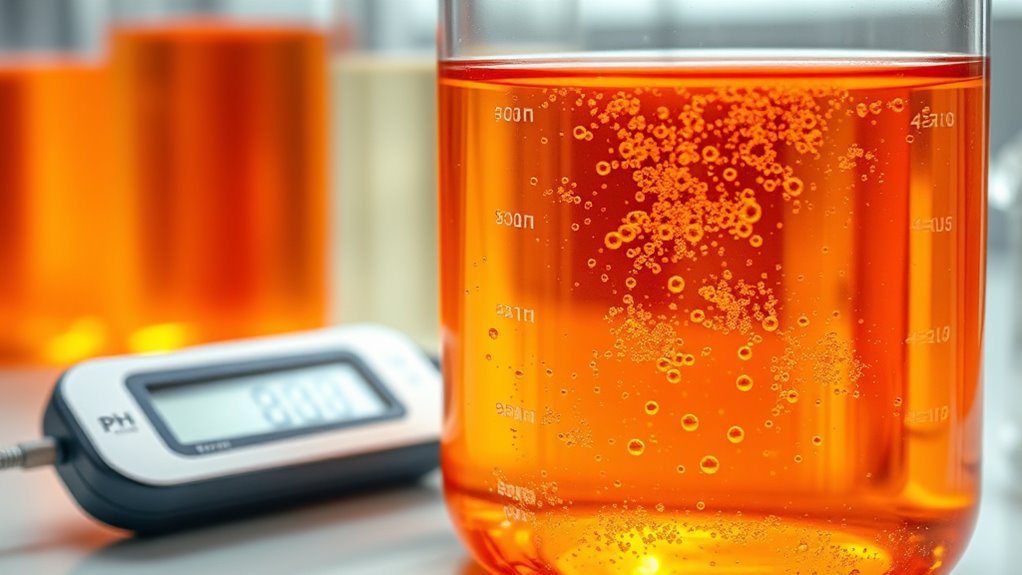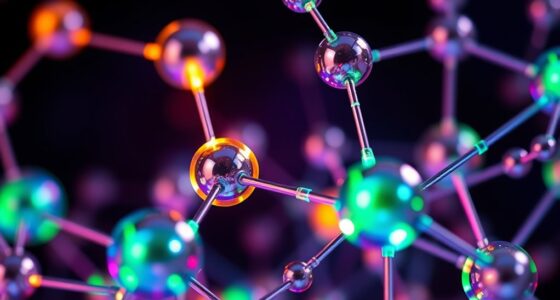Buffer solutions stabilize pH by containing weak acids and their conjugate bases that neutralize added acids or bases. They act like a cushion, resisting sudden pH changes in biological systems, industrial processes, or household products. Their effectiveness depends on concentration and the right ratio of components. Understanding how they work helps explain their essential role in maintaining consistent pH levels. Keep exploring to discover how buffers impact everyday life and science.
Key Takeaways
- Buffer solutions contain weak acid-base pairs that neutralize added acids or bases, maintaining a stable pH.
- They resist pH changes within the pH = pKₐ ± 1 range, ensuring biological and chemical stability.
- Buffer capacity depends on the concentration of components, allowing them to handle various amounts of acids or bases.
- They are essential in biological systems, industrial processes, and household products to prevent pH-related damage.
- Buffer solutions help maintain consistent pH, supporting safety, effectiveness, and proper functioning of many systems.
What Are Buffer Solutions?
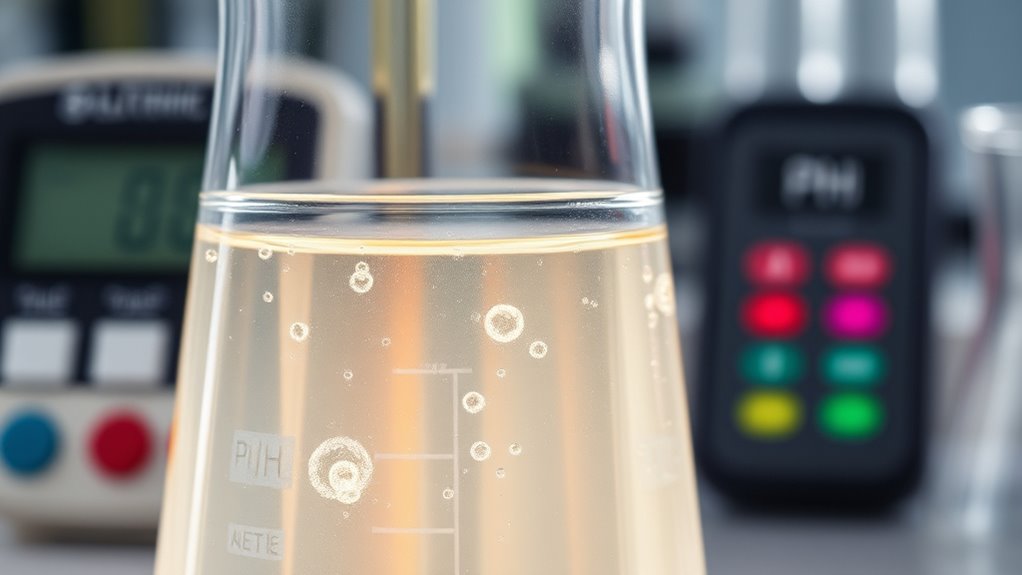
Have you ever wondered how solutions maintain a stable pH despite the addition of acids or bases? That’s the role of buffer solutions. They resist pH changes by neutralizing small amounts of added acids or bases, keeping the pH steady. A buffer contains a conjugate acid-base pair—usually a weak acid and its conjugate base or vice versa. Both components are present in significant concentrations to maintain equilibrium. When strong acids or bases are added, the buffer reacts to neutralize them, preventing drastic pH shifts. Buffers have a specific pH range where they work most effectively, and their capacity depends on the concentration of components. This stability is crucial for biological processes, industrial applications, and laboratory experiments, ensuring conditions remain consistent even when minor chemical changes occur. Understanding the importance of buffers in life processes helps highlight their role in maintaining homeostasis and supporting vital functions. Additionally, the effectiveness of a buffer system relies on its buffer capacity, which determines how much acid or base it can neutralize before the pH begins to change significantly. Recognizing how buffers operate can also shed light on their influence in ph regulation within living organisms.
The Chemistry Behind Buffer Functionality

The chemistry behind buffer functionality relies on the ability of a weak acid and its conjugate base to exchange protons, which allows the buffer to neutralize added acids or bases. When you add an acid, the conjugate base reacts with H+ ions, forming more of the weak acid. Conversely, if you add a base, the weak acid dons H+ ions to neutralize OH-, producing water. This exchange maintains a stable pH by shifting the chemical equilibrium. The effectiveness depends on the concentrations of the weak acid and conjugate base, as well as their ratio, which can be calculated using the Henderson-Hasselbalch equation. No matter how much you dilute the solution, as long as this ratio remains constant, the buffer continues to resist pH changes efficiently. Understanding industry trends helps in selecting appropriate buffers for different applications. Additionally, the track development process can influence how well a buffer performs in complex systems. Proper understanding of the buffer capacity is essential for optimizing their use in various fields.
How Buffers Maintain Ph Stability in Biological Systems
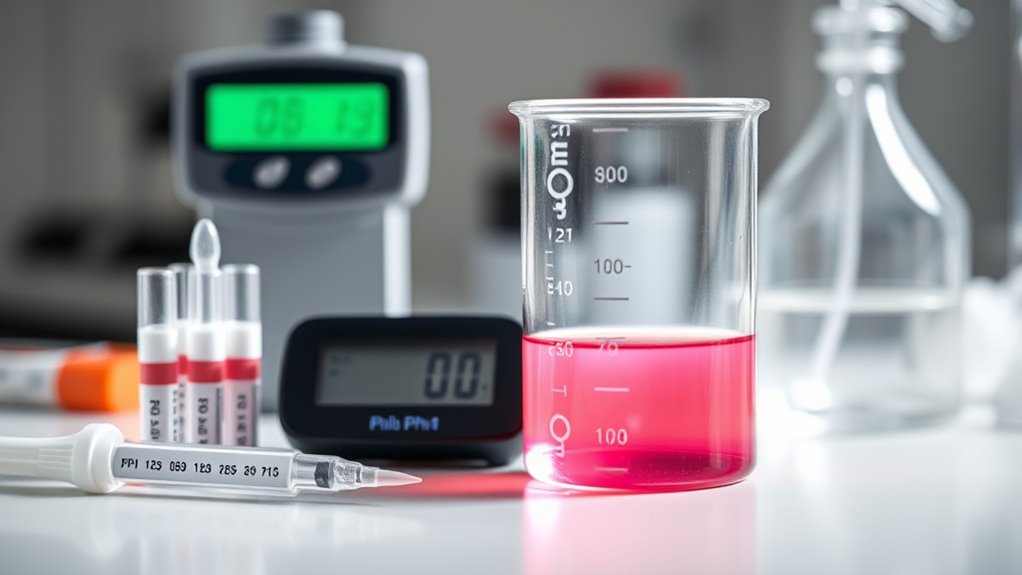
Biological systems rely on buffer solutions to maintain stable pH levels despite ongoing metabolic activities. These buffers work by neutralizing excess acids or bases, keeping pH within a narrow range essential for proper function.
For example, the blood’s carbonic acid-bicarbonate system adjusts quickly through respiration, converting CO₂ into bicarbonate or releasing it as needed. Proteins also act as buffers via their amino acid groups, accepting or donating hydrogen ions to stabilize pH.
Cellular buffers, such as phosphate and intracellular proteins, contribute to maintaining pH in specific compartments. This dynamic equilibrium prevents harmful pH shifts that could impair enzyme activity, disrupt cellular processes, or cause conditions like acidosis or alkalosis.
The Role of Buffer Capacity and Range
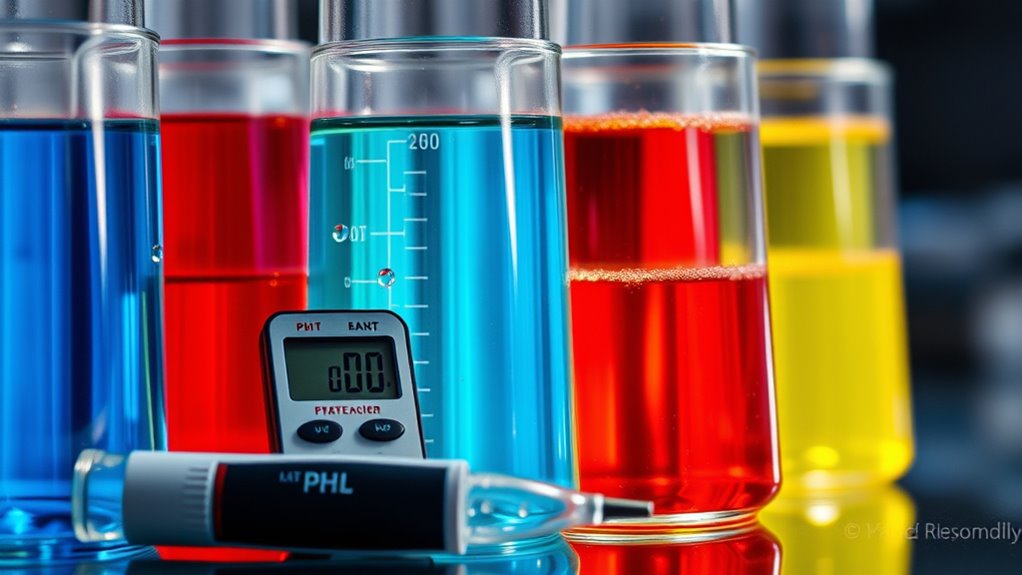
Understanding buffer capacity is essential because it determines how well a solution can resist pH changes when acids or bases are added. The higher the concentration of weak acid or base components, the greater the buffer capacity, allowing you to add more acid or base before the pH shifts markedly. A new sentence with buffer component concentration and the rest of the sentence. Tableware plays a role in social gatherings where pH-sensitive food items might be served, highlighting the importance of proper dining settings. This capacity is measured as the moles of acid or base per liter needed to change the pH by one unit. It diminishes quickly as buffer components are depleted, especially below 10% of their original levels. The buffer range, typically pH = pKₐ ± 1, defines where the buffer is effective. Within this range, pH remains stable, but outside it, buffering action drops sharply, making it vital to operate within the ideal range for reliable pH control. Additionally, maintaining the appropriate buffer range ensures the effectiveness of pH regulation in various scientific and industrial applications.
Methods to Prepare and Use Buffer Solutions

Preparing and using buffer solutions involves careful measurement and mixing of acid and base components to achieve the desired pH. Start with concentrated stock solutions of strong acids and bases, which serve as reliable, standardized reservoirs for creating buffers. Precise measurement of these stocks allows you to mix components in the correct proportions, often using titration methods and pH monitoring to reach the target pH. Additionally, understanding the history of scientific developments related to pH measurement can provide valuable context for accurate buffer preparation. After initial adjustment, fine-tune the pH by adding small amounts of acid or base, ensuring thorough mixing after each addition. Finally, adjust the final volume with distilled water and recheck the pH to confirm stability. Using the Henderson-Hasselbalch equation helps estimate the ratio of acid to base needed, streamlining the preparation process for accurate, effective buffers.
Environmental and Industrial Applications of Buffers

Buffer solutions play a vital role in both environmental management and industrial processes by maintaining stable pH levels essential for ideal performance.
In wastewater treatment, buffers ensure microbial activity remains efficient by controlling pH, preventing acidic or basic contaminants from disrupting processes, and stabilizing pH during chemical precipitation for heavy metal removal. They also minimize harmful disinfection by-products during chlorination.
In drinking water treatment, buffers prevent pipe corrosion, enhance disinfectant effectiveness, and reduce fluctuations that cause taste or odor issues.
In agriculture, buffers stabilize soil and water pH, improving nutrient availability and crop health. Vegetative buffers also reduce erosion and trap pollutants.
Industrially, buffers maintain pH in food, pharmaceuticals, and manufacturing, guaranteeing product quality and equipment longevity. They also support environmental conservation by preventing pollution and conserving energy.
The Significance of Buffers in Daily Life and Industry
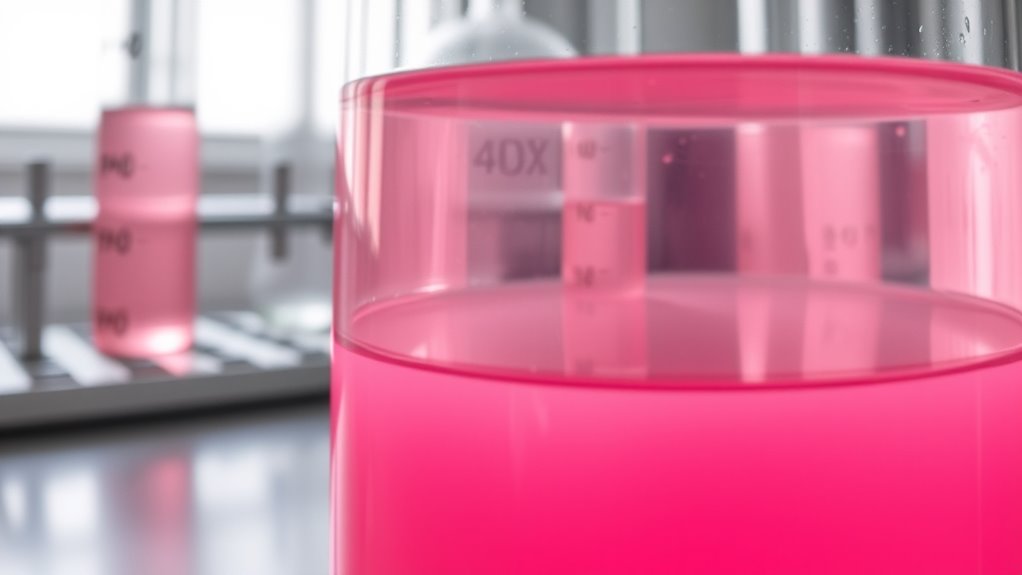
Buffers are essential in everyday life and industry because they help maintain stable pH levels that are critical for many processes.
Buffers are vital for maintaining stable pH in daily life and industrial processes.
In your body, buffers like bicarbonate, phosphate, and proteins keep blood and cells within healthy pH ranges, preventing harmful conditions like acidosis or alkalosis.
In food, buffers such as vinegar and baking soda guarantee products stay safe from microbial spoilage and achieve the right texture.
Personal care items use buffers to maintain skin-friendly pH, enhancing effectiveness and comfort.
In medicine, buffers stabilize drug formulations, ensuring safety and efficacy.
Household products like cleaners and detergents rely on buffers to keep pH balanced, protecting surfaces and skin.
Frequently Asked Questions
How Do Buffers Respond to Sudden Ph Changes?
When you add an acid or base suddenly, buffers respond by neutralizing the excess ions. If you add acid, the conjugate base reacts to neutralize H⁺ ions, keeping pH steady.
If you add base, the weak acid reacts with OH⁻ ions, preventing pH from rising. This quick response stabilizes the solution, ensuring minimal pH change and maintaining the environment’s balance.
Can Buffers Be Used in Extreme Ph Environments?
You might wonder if buffers work in extreme pH environments. While it’s possible, it’s challenging because suitable weak acids or bases with the right pKa values are hard to find.
In very acidic or basic conditions, buffers often lose effectiveness, and their components can degrade or react undesirably. Handling these buffers requires caution, and they’re typically specialized, designed for specific high or low pH applications in industry or research.
What Factors Affect a Buffer’S Effectiveness Over Time?
You should know that a buffer’s effectiveness over time depends on factors like concentration, pH stability, and environmental exposure. Higher concentrations of buffer components maintain better capacity, but dilution weakens it.
Exposure to CO₂, light, and contaminants can degrade components, reducing efficiency. Temperature changes and microbial growth also impact stability.
To keep buffers effective, you need proper storage and handling, avoiding extreme conditions that accelerate degradation.
Are There Natural Buffers in Ecosystems Besides Blood?
Yes, you’ll find natural buffers in ecosystems beyond blood. Wetlands act as flood buffers, absorbing excess water and protecting communities.
Forests filter pollutants and stabilize stream banks, while coastal dunes serve as erosion barriers. Riparian zones help maintain water quality, and floodplains absorb floodwaters.
These natural buffers protect ecosystems and human settlements by reducing risks, supporting biodiversity, and promoting resilience against natural disasters.
How Do Buffer Solutions Differ in Biological Versus Industrial Applications?
Imagine two different tools in your toolbox—one delicate and precise, the other rugged and versatile. Biological buffers are like fine instruments, maintaining a narrow pH range to protect cells and proteins.
Industrial buffers are like heavy-duty gear, handling wide pH swings for large-scale processes. You’ll find biological buffers in labs and healthcare, while industrial ones are used in manufacturing or wastewater treatment, each tailored for their unique environment.
Conclusion
Understanding buffers helps you appreciate their role in keeping solutions stable, pH balanced, and life functioning smoothly. Whether you’re adjusting a recipe, maintaining a biological system, or protecting the environment, buffers work tirelessly behind the scenes. They resist change, support stability, and guarantee consistency. By knowing how buffers operate and why they matter, you can better grasp their importance in everyday life, industry, and nature—making your world a more balanced, reliable place.
